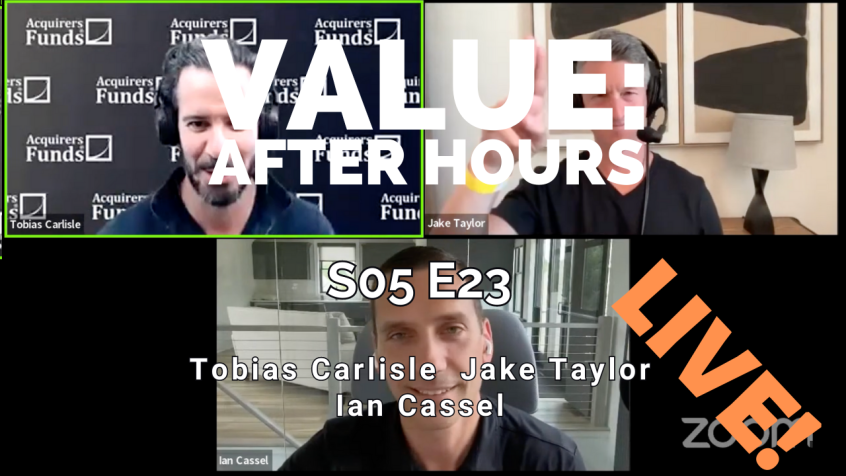During their latest episode of the VALUE: After Hours Podcast, Cassel, Taylor, and Carlisle discuss Finding Picasso-Type Situations. Here’s an excerpt from the episode:
Ian: But where we were going back and forth was just on the small outstanding share count. I do find when a company has 10 million shares outstanding or less, I think it just sets itself up to be a Picasso type situation, like Pablo Picasso.
Jake: Scarcity. Yeah.
Ian: Yeah, scarcity. Pablo Picasso, I think he produced 1,900 original paintings over his career. Most of them are being held by private collectors and museums. Very few of them come up for sale every year, maybe one or two. When one or two come up for sale, they go for tens of millions or $100 million plus, because it’s a wealth status symbol owning one of those paintings. There’s just a scarcity of those types of things out there. I think when you find a great business, that is a one of one business, and it’s high organic growth rate, it has a few amount of shares outstanding. There’s always going to be another wave of capital that wants to participate in that. When you have a small amount of shares outstanding, people have to pay up to acquire shares just like that Picasso. That’s what I’m interested in finding. I don’t know, it sounds too grossy to say this, but I believe it. I’m going to find things that are undervalued that can get overvalued. [crosstalk]
Jake: What do you do about figuring out management to make sure that that small number of shares doesn’t become a large number of shares that are in their pocket? [chuckles]
Ian: I remember I did this, this was like six, seven years ago. But overall, I believe it’s around 16% to 17% of all micro caps, at least in North America, are profitable.
Jake: Okay.
Ian: Usually, when I tell anybody, that’s new to microcap investing, focus on those 17% and a lot of your worries go away.
Jake: Right.
Ian: This was a long time ago, but I remember looking at, what was the share structure of the companies that were profitable? I think at that time, it was 45% of the profitable micro caps had 20 million shares or less outstanding. And so, it goes back to that whole theory of great owner operators, people that care about their share structure and that treat their shares like gold. It makes sense that they would have less shares outstanding. They don’t dilute readily. They don’t want to dilute. They want to keep those shares. They know the earnings power of increasing EPS. And so, generally, what I find too is, the companies that have a small amount of shares outstanding that don’t have preferred or different classes of shares, don’t have a lot of warrants or options that incentivize properly. Those people that are doing the right thing are mainly these companies that have a smaller amount of shares outstanding. [crosstalk]
Also, especially here in the US, not to cut you off, Toby, but not here in the US. The other thing about few shares outstanding is, let’s say you have 10 million shares out, you have a company earns $10 million a year. That’s a dollar per share. You have a company with 100 million shares out, they own $10 million a year, that’s 10 cents a share. Well, that one with 10 million shares outstanding is probably going to trade at $10, plus the one with 100 million shares outstanding is going to trade at a $1 or $2. Here in the US at least, you have different types. Institutions can’t buy that thing, that’s a $1 or $2, but they can look at the thing that’s $10 plus because of penny stock rules. [crosstalk]
Jake: Right. There’s some structural cut offs that-
Ian: Exactly.
Jake: -screen you out of the game there.
Ian: So, when you have lesser shares outstanding, you actually have a higher stock price. It sets you up to be viewed by larger pools of capital that can potentially participate in owning your company.
Tobias: It’s a pretty solid quant screen you’ve produced there, Ian.
Jake: [laughter]
Tobias: So, Mark [unintelligible [00:39:05] said the same thing about the shares outstanding on this podcast when he was on a while ago. The reason that what I wondered was, there are probably two types of management teams that come out. There’s a lot in particular in smaller micro cap land where the business is a marginal business, but they’re making their money by selling shares in this business. And so, they have huge numbers of shares that’s saying, they don’t really ever need to make money at a company level because that’s not how they make their money. So, I was wondering how you screen those guys out. So, that’s interesting.
The function is that, if the market cap is going to be sub-hundred million, and you need the share price to be over $10 when it crosses $100 million or thereabouts, then they need to be 10 million shares outstanding. So, it’s just you back into the 10 million share number. So, that works really well. That’s a good little model.
You can find out more about the VALUE: After Hours Podcast here – VALUE: After Hours Podcast. You can also listen to the podcast on your favorite podcast platforms here:
For all the latest news and podcasts, join our free newsletter here.
Don’t forget to check out our FREE Large Cap 1000 – Stock Screener, here at The Acquirer’s Multiple:




